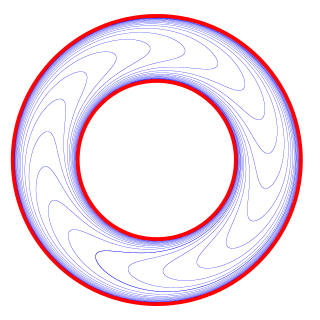In mathematics, a binary relation associates elements of one set, called the domain, with elements of another set, called the codomain. A binary relation over sets and is a set of ordered pairs consisting of elements from and from . It is a generalization of the more widely understood idea of a unary function. It encodes the common concept of relation: an element is related to an element , if and only if the pair belongs to the set of ordered pairs that defines the binary relation. A binary relation is the most studied special case of an -ary relation over sets , which is a subset of the Cartesian product

In mathematics, an equivalence relation is a binary relation that is reflexive, symmetric and transitive. The equipollence relation between line segments in geometry is a common example of an equivalence relation. A simpler example is equality. Any number is equal to itself (reflexive). If , then (symmetric). If and , then (transitive).

A quotient group or factor group is a mathematical group obtained by aggregating similar elements of a larger group using an equivalence relation that preserves some of the group structure. For example, the cyclic group of addition modulo n can be obtained from the group of integers under addition by identifying elements that differ by a multiple of and defining a group structure that operates on each such class as a single entity. It is part of the mathematical field known as group theory.
In mathematics, an integral domain is a nonzero commutative ring in which the product of any two nonzero elements is nonzero. Integral domains are generalizations of the ring of integers and provide a natural setting for studying divisibility. In an integral domain, every nonzero element a has the cancellation property, that is, if a ≠ 0, an equality ab = ac implies b = c.

In mathematics, modular arithmetic is a system of arithmetic for integers, where numbers "wrap around" when reaching a certain value, called the modulus. The modern approach to modular arithmetic was developed by Carl Friedrich Gauss in his book Disquisitiones Arithmeticae, published in 1801.
In mathematics, rings are algebraic structures that generalize fields: multiplication need not be commutative and multiplicative inverses need not exist. Informally, a ring is a set equipped with two binary operations satisfying properties analogous to those of addition and multiplication of integers. Ring elements may be numbers such as integers or complex numbers, but they may also be non-numerical objects such as polynomials, square matrices, functions, and power series.
In mathematics, the extended real number system is obtained from the real number system by adding two infinity elements: and where the infinities are treated as actual numbers. It is useful in describing the algebra on infinities and the various limiting behaviors in calculus and mathematical analysis, especially in the theory of measure and integration. The extended real number system is denoted or or It is the Dedekind–MacNeille completion of the real numbers.
In category theory, an epimorphism is a morphism f : X → Y that is right-cancellative in the sense that, for all objects Z and all morphisms g1, g2: Y → Z,

In mathematics, a foliation is an equivalence relation on an n-manifold, the equivalence classes being connected, injectively immersed submanifolds, all of the same dimension p, modeled on the decomposition of the real coordinate space Rn into the cosets x + Rp of the standardly embedded subspace Rp. The equivalence classes are called the leaves of the foliation. If the manifold and/or the submanifolds are required to have a piecewise-linear, differentiable, or analytic structure then one defines piecewise-linear, differentiable, or analytic foliations, respectively. In the most important case of differentiable foliation of class Cr it is usually understood that r ≥ 1. The number p is called the dimension of the foliation and q = n − p is called its codimension.
In mathematics, a congruence subgroup of a matrix group with integer entries is a subgroup defined by congruence conditions on the entries. A very simple example is the subgroup of invertible 2 × 2 integer matrices of determinant 1 in which the off-diagonal entries are even. More generally, the notion of congruence subgroup can be defined for arithmetic subgroups of algebraic groups; that is, those for which we have a notion of 'integral structure' and can define reduction maps modulo an integer.

In real analysis, the projectively extended real line, is the extension of the set of the real numbers, , by a point denoted ∞. It is thus the set with the standard arithmetic operations extended where possible, and is sometimes denoted by or The added point is called the point at infinity, because it is considered as a neighbour of both ends of the real line. More precisely, the point at infinity is the limit of every sequence of real numbers whose absolute values are increasing and unbounded.
In mathematical notation for numbers, a signed-digit representation is a positional numeral system with a set of signed digits used to encode the integers.

The dyadic transformation is the mapping
In number theory, natural density, also referred to as asymptotic density or arithmetic density, is one method to measure how "large" a subset of the set of natural numbers is. It relies chiefly on the probability of encountering members of the desired subset when combing through the interval [1, n] as n grows large.
In mathematics, a CR manifold, or Cauchy–Riemann manifold, is a differentiable manifold together with a geometric structure modeled on that of a real hypersurface in a complex vector space, or more generally modeled on an edge of a wedge.
In universal algebra and in model theory, a structure consists of a set along with a collection of finitary operations and relations that are defined on it.
In mathematics, a de Rham curve is a continuous fractal curve obtained as the image of the Cantor space, or, equivalently, from the base-two expansion of the real numbers in the unit interval. Many well-known fractal curves, including the Cantor function, Cesàro–Faber curve, Minkowski's question mark function, blancmange curve, and the Koch curve are all examples of de Rham curves. The general form of the curve was first described by Georges de Rham in 1957.
In mathematics, particularly in the area of arithmetic, a modular multiplicative inverse of an integer a is an integer x such that the product ax is congruent to 1 with respect to the modulus m. In the standard notation of modular arithmetic this congruence is written as
In probability theory, a standard probability space, also called Lebesgue–Rokhlin probability space or just Lebesgue space is a probability space satisfying certain assumptions introduced by Vladimir Rokhlin in 1940. Informally, it is a probability space consisting of an interval and/or a finite or countable number of atoms.
In computer science and mathematics, more precisely in automata theory, model theory and formal language, a regular numerical predicate is a kind of relation over integers. Regular numerical predicates can also be considered as a subset of for some arity . One of the main interests of this class of predicates is that it can be defined in plenty of different ways, using different logical formalisms. Furthermore, most of the definitions use only basic notions, and thus allows to relate foundations of various fields of fundamental computer science such as automata theory, syntactic semigroup, model theory and semigroup theory.






























































